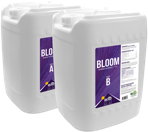Growing in Coco: Best Practices
Coco coir substrates are a popular choice for cannabis cultivation. Coco coir is a sustainable and renewable resource and can be easily composted after use. It can be purchased loose or compressed (for growing in containers) or in compressed grow cubes (as an alternative to rockwool blocks). Coco coir can be used once and discarded or used as a top dressing for raised beds and field soil to increase organic matter and moisture retention in heavy clay or sandy soils.
MOISTURE MANAGEMENT
In order to properly manage substrate moisture and nutrient availability in coco coir, it is important to understand a few key terms. Saturation describes the total volume of water a substrate can hold by percent of substrate weight, or the water holding capacity (WHC). Field capacity describes the available water content in a substrate after excess water has drained. Permanent wilting point occurs when there is no remaining moisture available for plants to extract from the substrate.
Substrates like coco coir that consist of high organic matter will decompose during the production cycle, leading to changes in the air to water ratio. This highlights the importance of consistent moisture monitoring and irrigation adjustments based on moisture readings. A soil moisture sensor that measures volume water content (VWC, %) is a simple tool that can be placed into the root zone to monitor moisture.
Using the Solus Teros 12 substrate sensor, coco is fully saturated at 40% and needs water near 20%. Consistently over saturated media greatly increases the risk of root diseases and decreased crop yields. Media that dries to the permanent wilting point may cause irreversible damage to plant roots. It is important to maintain consistent moisture to ensure root absorption of nutrients without allowing plants to reach the wilting point.
IRRIGATION STRATEGY
Focus on a proactive rather than a reactive approach. Irrigation should be timed properly to allow for consistent moisture levels and nutrient delivery without overwatering or overfeeding. Before planning irrigation, use the test detailed above to identify the saturation range to the wilting point.
Irrigation timing and volume will largely depend on environmental conditions and irrigation system components. A general rule of thumb is to apply 10-15% more water than the container will hold. This allows for some runoff with each irrigation and reduces the potential for salt accumulation. The flow rate must be adjusted to allow thorough media saturation but avoid overflow of the container.
The first irrigation typically starts one hour after lights on or sunrise and ends one hour before lights off or sunset. Irrigations can be scheduled hourly or more frequently, depending on conditions. Excessive dry down between irrigations may increase soluble salt concentration and contribute to hydrophobic properties of the substrate. Clear water flushing of the coir substrate between nutrient feedings is an effective procedure to reduce and prevent salt buildup.
OUR COCO COIR PRODUCTS
Rx Green Technologies offers a variety of coco coir substrates to choose from, including loose coco and coco grow bags. CLEAN COCO is available as loose coco coir in 100% coco and 70% coco/30% perlite blends. Loose coco is ideal for filling reusable or disposable pots, as well as topping off and refilling seasonal outdoor pots and beds.
CLEAN COCO grow bags contain a compressed brick of pure coco coir in a disposable, mesh bag. Simply hydrate the brick and transplant your rooted clone or young vegetative plant into a 1-gallon, 2-gallon, or 3-gallon bag. This is an ideal option for large scale cultivation facilities with automated irrigation, as well as any grower looking to cut down on labor expenditure with pot filling and transplanting.
CLEAN COCO cubes contain a compressed brick of pure coir, packaged in a mesh bag that allows root penetration. Similar to grow bags, simply hydrate the cubes and place seeds, rooted cuttings or small plants in the pre-drilled hole. These are ideal for smaller plants (less than 24” height) in drip irrigation and can be easily composted after crop harvest. While the cubes can be used in food irrigation, the product is best suited for drip irrigation.
STORAGE AND DISPOSAL
All coco substrate products should be stored in a dry area, off the ground, and protected from the elements. Loose coco is sold in biodegradable bags. Used loose coco may be reused, composted, or disposed of in a landfill.
Resources
Soil moisture meters
Aroya Teros 12 Substrate Sensor, https://aroya.io/cultivation/

